

 |
|
||
| 1970 Buick LeSabre | Back: rv8
 |
||
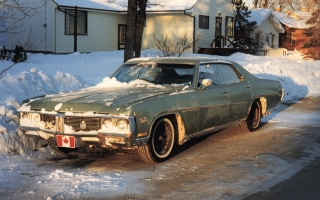
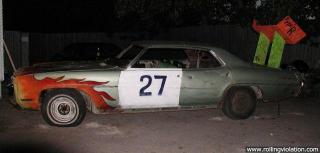
| Specs:
Buick 350 Cubic Inch V8 4 Barrel Quadrajet Carb 285 gross hp @ 4600 rpm * 375 ft-lbs @ 3200 rpm 3 speed automatic transmission 123" wheelbase, approx 240+ inches overall length. 4200+ lbs. approx curb weight. |
Performance:
0-60: ~10 - 15 seconds. 1/4 mile: ~17 - 20 seconds Top Speed: 110+ mph 60-0: very, very far. Don't try it twice. |
When and how much:
$125. October 1996 - present.
Intro:
(This isn't a cheap shot against old guys in big cars,
just the old guy who used to own this one.)
This thing has to be the ultimate
"rolling violation." Would you believe this thing SOMEHOW passed
a safety? Originally owned by some old guy who used to park using
the "feel" parking method, I purchased this beauty in the fall of 1996
for $125 needing only a transmission leak taken care of. I origingally
thought I had gotten a scream of a deal for a winter car. Little did I know
how much screaming would be involved, most of it at the car when it would leave me
stranded in -40.
FYI: The "feel" parking method is the
type of parking where you pull into the stall/garage until you feel the
car hit something. If done properly, you can end up with nice rounded
corners on the car, and matching dents in the fenders.
For reasons I cannot explain, everyone
seems to think this is the coolest old car ever. Frankly, I don't
know what kind of crack they are smoking. This thing was a real PITA,
and the worst winter car I've ever owned. Every winter it
blew up, and I ended up taking the bus or finding alternate transportation
for a good chunk of the winter.
The Love Machine.
This is best said with a bad Cheech
and Chong type Mexican accent. (ok, so I'm an equal opportunity pig
- I'll make fun of everyone on my web site eventually including straight
white guys, so stay tuned.) Anyway, this thing picked up the nickname
Luv Machine. Maybe because there is more room in the backseat than
in a typical 2 bedroom house, but no one who ever called it the Love Machine
ever tried to impress women with it. In fact, the first time my girlfriend
(now wife) saw it, I was horrified! She wasn't impressed at all...
but at least she thought it was funny. She's still around, so maybe
it IS the Love Machine.
Size matters. Crumple Zones.
Size does matter. At least,
that's what the guys at Buick must have been thinking with this beast.
20 feet long. That's 240 inches, or 6.1 metres for you metric types.
Most full size extended cab pickup trucks aren't as long. Many airliners
aren't as long. The bumpers always make me laugh - they are 200 pounds
of chrome plated steel bolted directly to the end of the frame. None
of those sissy "impact absorbing" bumpers. Whatever you hit is the
crumple zone. Assuming you hit something solid enough to make the
car lose (like a concrete truck), there's about 10 feet of front end to crush
and absorb the energy. You will also have the safety of five seatbelts
in the front. Unfortunately, that's not to seat five people (although
there is room), but due to the idiotic seatbelt design. The outboard
belts (I keep wanting to say window seat) are two separate belts - one
for the lap belt, and one for the shoulder belt.
Even with all that metal, and all
those seatbelts, I still feel safer in a new car. A new car "gives"
for you, whereas this one just "gives to you." That, and there's
a good chance you could avoid the accident in a new car.
They don't build them like this anymore - and that's not a bad thing.
For all you people who wish cars were
still built like this, you can borrow it any time you want. (I still
have it.) You will discover the pleasures of points ignition, 4 wheel
drum brakes, manual chokes, 8 mpg fuel economy, seasickness inducing handling
and many more fun things. Ok, you can't anymore... the car is being turned
into a demolition derby car but click here to see the pictures.
Points ignition. For those
who have never had the pleasure of changing points, I'll try and sum it
up. It's easy, but used to have to be done every 6 months (or more.)
Changing the points isn't hard - it's only a few screws, but then you have
to set the dwell and timing. Most cars now don't even have a way
to set the timing, and never need the base timing adjusted. The worst
part of points is the fact they just barely handle the power of a stock
ignition system without melting, and if you try and hop up the car, you'll
be changing points weekly unless you upgrade them.
For those who don't know what points
are, they are the "trigger" for the coil to fire the spark plug.
They are a mechanical switch, much like a light switch, and at the high
voltages in the ignition have a tendancy to arc and eventually burn out
the contacts. They are high maintenance to keep at the correct distance,
angle (dwell) and they need to be changed often as the contacts wear out
due to the arcing.
Four Wheel drum brakes.
I don't even like rear drum brakes, and this thing has 4 wheel drums.
They are massive drums on the front, but suffer from three major flaws.
First, they aren't self adjusting. That means you have to adjust
them every few thousand miles from under the car. Secondly, they
don't modulate well - they have "on" and "off" modes. Very hard to
slow down smoothly with them. Lastly, they fade. I once brought
the car up to about 110 mph, and there was enough brakes to stop, but they
were already starting to fade and smell in one stop. I couldn't imagine
trying to do that more than twice before expecting to see molten brake
shoe or flames coming out of the wheel wells.
Manual chokes. Another
idea that is long gone, and won't be missed anytime soon. For those
of you who have never tried to start a car in -40 with a manual choke,
the procedure goes something like:
1. Pump gas two - three times.
2. Pull choke to full on position.
3. Turn key. (Car will start and stall.)
4. Repeat steps one to three until car stays running.
5. Depress choke partway.
6. When car stalls, repeat steps one
to 5 until car stays running. (usually only 3-5 times)
6a. Occasionally, you'll need
to hook up the battery charger to keep turning it over.
7. Modulate gas pedal to keep car
running. (The fast idle doesn't work either.)
8. Get gas. You'll use about a quarter tank to warm it up when it's
-40 outside...
8. Shower. You smell like a gas station.
For those who used to own a car of
this vintage, yes, it did originally come with an automatic choke.
It broke. I replaced the carb with one from Darren's
collection. There are a couple of different choke styles, and I was
too cheap (broke) to overhaul a carb for a 28 year old car, so we went
with a manual choke. Stupid idea. Manual chokes suck even more than broken
automatic chokes.
(How to pressure test your carb: replace
your fuel pump. This is what caused the carb to be replaced.
I went from a small leak around the throttle plates to a gasoline geyser.
I quickly found out why the car wasn't idling so well, a half cup of liquid
gas in the intake manifold will do that... That partially explains
the 7 mpg fuel economy and exhaust fumes that could be collected and reprocessed
and could power a Honda Civic on...)
Noteable repairs:
I'm not sure what's with my cars and
blown transmissions, but I blew up another one.
In my defense,
it was leaking when I bought the car, and I suspect it may have been a
cracked case as no one could ever pinpoint the leak. (the whole bottom of the
car was covered in transmission fluid)
Oddly enough, Darren gets another
special mention on this one. I was showing off, and got the car stuck
in a snowbank. Later that night, I let Darren drive. He decided
he was going to show me how to take that corner, and he got the car stuck
in the snowbank. Same snowbank, much more stuck. We went through
9 litres (about 2 gallons) of transmission fluid on the ride home, it was
leaking so bad. In another freak coincidence, the tranny blew up
very soon after.
Darren did repay his debt by helping
me change the transmission. He also volunteered his father's driveway
as the ideal location to do it in. (You might have read about Crazy
Ivan on rv7's page or on Darren's
page.)
One advantage to cars built before
downsizing: underhood room. On most RWD cars, the bolts that hold
the engine and transmission together are a challenge to remove. You
usually need to remove those bolts with multiple extensions, universal
joints and a whole lot of cussin'. On the Buick, you can remove them
from the top with a wrench. There is a LOT of room under the hood
for working, storing spare parts like a spare engine, etc.
I discovered the TH350 transmission
comes in a few different cases. Not only are there two bolt patterns
(Chevy & Buick-Oldsmobile-Pontiac) but there are three different tailshaft
lengths. Unfortunately, the TH350 Buick bolt pattern in the long
tail is a rare breed - I had a hard time tracking one down and ended up
paying more than a generic Chevy one.
Other fun stuff: Wheel studs.
This thing snapped studs like they were candy canes in the hands of a ten
year old. Over time, I ended up replacing all of them. The
rotor in the distributor broke. It didn't wear out, but physically
broke in half. The rotor doesn't touch anything?! The starter
fragged when it was -30, and would test fine in the store. Permaflat
brand tires, with the only one that never lost any air was the original
looking bias-ply spare.
Although I'm sure everyone wants to
read pages and pages of stupid car repair tricks, I'll sum it up:
worst winter car ever. Every winter, it blew up something that would
leave the car dead and me taking the bus.
Snowbank Hunting:
About the only fun part of driving
this thing was driving the crap out of it, and going snowbank hunting.
Never met a snowbank it couldn't kill. Occasionally you might have
to dig out, but most of the time you just slammed it into reverse and backed
out.
More pictures of other 60's-70's Buicks: (click 'em for bigger versions)
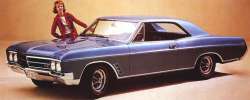 a 1966 Buick GranSport
a 1966 Buick GranSport
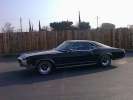 a 1968 Buick Riviera
a 1968 Buick Riviera
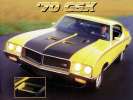
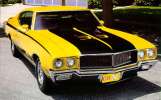 two shots of the awesome 1970 Buick GSX.
two shots of the awesome 1970 Buick GSX.
(as usual, I've forgotten where I've amassed these pics
from, but please feel free to correct
me and let me know who owns them.)
Links:
There might be sites devoted to this car, but I'm not
exactly a Buick LeSabre enthusiast. :)
It was fun to watch people vote - the results are in... and I'm demo-derbying it anyway.
First place: Give it to my sister.
Second place: Demolition Derby.
Third place: Crush it into a coffee table.
Fourth Place: Pull the engine and use it in the Trans Am.
Last Place: Cut the roof off, weld the doors shut and drive it redneck style.
To see the Buick in action, check out the racing schedule and
check the demo page for pictures if you miss the demo.
Credits:
Jamie for selling it to me at such a great price.
Darren for being a willing victim for all the repairs.
Nicole for not dumping me the second she saw the car.
Jacqueline for nicknaming it the Luv Machine.
Notes:
Once again, a discrepancy for engine HP ratings.
I've seen 260, 285 and 315 hp for the 1970 Buick 350. Seeing as how
the engine has probably almost 200,000 miles on it I highly doubt it's
making that much power anyway. With a tune up, it might be 200 net
hp. Net HP is about 30% less than gross HP - how they used to measure
it before 1972.
rv1 |
rv2 |
rv3 |
rv4 |
rv5 |
rv6 |
rv7 |
rv8 |
 rv9 |
 rv10 |
 rv11 |
 rv12 |
 rv13 |
 rv14 |
 rv15 |